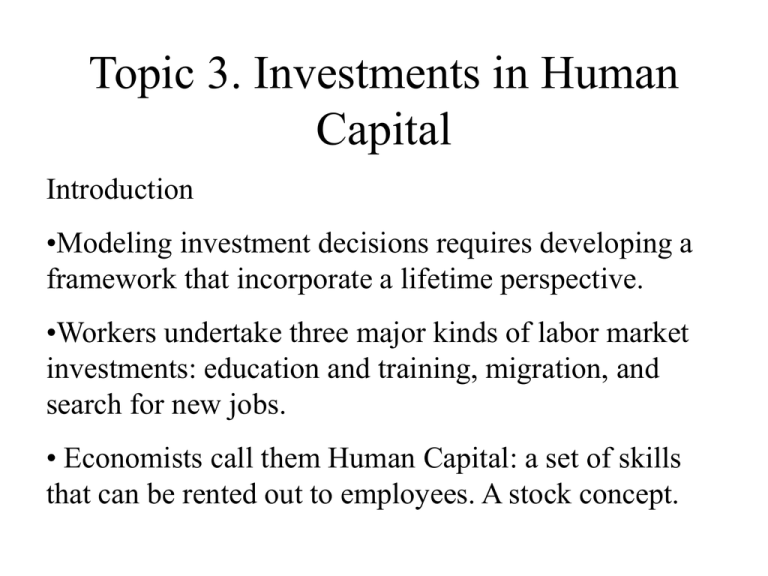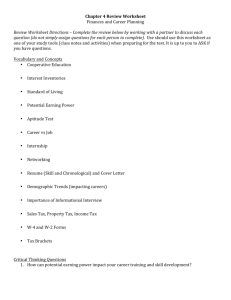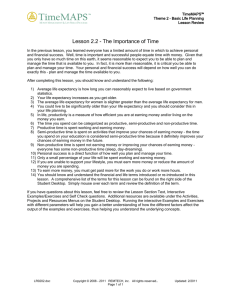Topic 3. Investments in Human Capital
advertisement

Topic 3. Investments in Human Capital Introduction •Modeling investment decisions requires developing a framework that incorporate a lifetime perspective. •Workers undertake three major kinds of labor market investments: education and training, migration, and search for new jobs. • Economists call them Human Capital: a set of skills that can be rented out to employees. A stock concept. • Society’s total wealth is a combination of human and non-human capital. • 60 percent of estimated national wealth was derived from investments in human capital. • Three stages of investments: a. early childhood determined by parents, community; b. as students in high school, college or vocational training; c on the job training, night school, formal training. • We want to explain why people faced with what appears to be the same environments make different choices. • We will see that individuals’ decisions about investing in human capital are affected by innated ability, their aspirations and expectations about the future, and access to financial resources. Basic model: human capital investments • • Like any other investment, an investment in hc entails costs with expected benefits accrued in the future. Costs of this investments are 1. Out of pocket or direct expenses: tuition, books, etc. 2. Foregone earning 3. Psychic losses • For education and training, expected returns are in the form of higher future earnings, increased job satisfaction over their lifetime, and a greater appreciation of nonmarket activities. • We need to discount this stream of benefits. • Assuming a utility maximization consumer • For investment in additional schooling, we compare if sum over B/ (1+r) > C • If r is known, we can just compare this equation. • Or we can find IRR, the largest r that make this project profitable. In other words, if IRR > interest rate, we will invest. • Optimum acquisition of human capital baht mc’ mc mb hc Demand for a college education • Facts Alternative earning streams age cost Predictions of the theory • Present-oriented people are less likely to go to college than the forward-looking one • Most college students will be young • College attendance will drop if costs rise • College attendance will rise if earning gap widens, other things equal. Prediction1:present-orientedness • Describe people who do not weight future events very heavily = who has a very high discount rate • Using the present-value method to calculate investment returns, imputed benefits will be smaller • Using the IRR, require the larger IRR . • Thus, these people are less likely to attend college. • Evidence: we don’t have discount rate of these people, but indirect evidence b/w edu and health. • We found that positive correlation b/w health and education. Health-concerned persons are forwardlooking. Prediction2: age • The young have a larger present value of total benefits than the older, because of longer time remaining for work. Prediction3 costs • Invesment more when costs are lower. • If foregone earning or tuition cost fall, ceteris paribus, we expect a rise in college enrolments. • For older people, costs of college atttendance are high. • Students with lower achievement or higher discount rate are more likely to be the margin, thus are most responsive to cost considerations. Prediction 4:earning differentials • Demand for education is pos. related to increases in lifetime earning. (expected) • Since expected earning, and occupational choice are uncertain, we can guess (decide) by looking at the avg returns. • Male enrolments in 80s declined • Women enrolments rise throughout decades • For individual, edu choices and occupational choices of friends and acquaintances affect investment decisions. (why) Postschooling investment in HC • Why training at work are needed? • Skill mismatched, technological change, job promotions. • Two types of training: general and specific • Examples of training. Money earning for fulltime male workers 1999 Figure 9.4 Money Earnings (Mean), for Full-Time, Year-Round Female Workers, 1999 These figures reveal 4 characteristics • 1. Avg earning of full-time workers rise with level of education • 2. Concave shape, rise rapidly early • 3. Earning differences are greater over time. • 4. Age/earning profiles of men tend to be more concave and to fan out more than those for women. • Can we use HC theory to explain these empirical regularities? 1. Average earnings rises with education: As implied by our investment model otherwise they did not have incentives to invest in education 2. Concavity and on-the-job training • 2 in 3 of wage growth occurred in the first ten years. • We can explain the early sharp rise in earning profiles and then slower in terms of OJT • OJT: learning by doing, formal training, informal training with more experienced workers • OJT reduces productivity of trainees during learning. • Training costs are either shared by workers and the employer for specific training, whereas borne mostly by employees for general training. • Generally, training reduces wage during the learning period, and then rise with enhanced productivity afterwards. • As with other forms of hc investment, we will invest in OJT more at young and less as we grow older. • In other words, hc investment decline with age. Figure 9.5 Investment in On-the-Job Training over the Life Cycle • In figure 9.5, Es is earning after schooling without further training • Ep is the potential earning from OJT • Ea is the actual earning • Gap between Ep and Ea is the actual cost of OJT. • As they age, the gap is lessen, so investment incentive declines with ages. 3. Earning gap becomes more pronounced as they age • Remind. We tend to invest more when the expected earning differentials are greater; or when investment costs are lower; or when you have more time to recoup benefits; or you have a lower discount rate; or you can learn quickly, shorten training time, or lower psychic losses. • Thus, this implies that workers who invested more in schooling will invest also more in postschooling training. 4. Men’s earnings profile more concave than those for women • Length of work life are different historically. • Women, in average, have fewer hours of works per week than men do. • Expected work life for women is shorter due to the role of women in child-rearing and household production. • This role makes women to drop out of the labor market during their childbearing year, reducing women’s work experience • This may cause employer to avoid hiring women for jobs requiring much OJT; women probably know this too. In all, women have less incentives to enter these occupations. • So the cause of the flatten earning profile for women can come from the less OJT of women Is Education a good Investment? • For individuals, most studies show that returns are close to other types of investment. • However, there are some biases in estimating returns to education. • Upward bias: not partial out effect of ability • Downward bias: some benefits are not captured; not include employee benefits. • Selection bias: conventionally, we compare the earning from college graduates and high school graduates. If in fact, in the absence of college education, your earning would have been less (cause you don’t like it), therefore ror is underestimated. In the opposite, the ror for high school graduate is overestimated. Is education a good social investment? • Are we putting enough resources to educating our current and future workforces? • Should the resources for education be reallocated in some way? • Should we demand more of students in elementary or secondary schools? • How education and productivity are related • What is the socially optimal level of schooling? Society should invest until marginal social rate of return equals the marginal ror on other forms of investment. • For LDCs, rors for secondary and higher educations appear to be higher than in developed countries. • Two hypotheses: education enhances worker productivity vs. education is a means of finding out who is productive. (it is just a signal for productivity) • Since worker’s productivity cannot be observed even long after employed, edu attainment as a hiring standard can increase firms’ profits even if education does not enhance productivity. Figure 9.7 The Benefits to Workers of Educational Signaling Figure 9.8 The Lifetime Benefits and Costs of Educational Signaling • For less productive worker, they will choose e=0, where gap bw benefit and costs are maximized: A0 > BD. • For productive worker, choosing e* will give him BF which is > A0. Signaling or Human capital • Agree: people with higher cognitive skill are likely to be more productive • Disagree: better schools can enhance worker productivity by improving cognitive skills. • Pro for signaling believes there is no strong relationship betweens school expenditures and student performance. • Pro for hc view believes that students attending higher-quality schools have higher subsequent earning, ceteris paribus.





